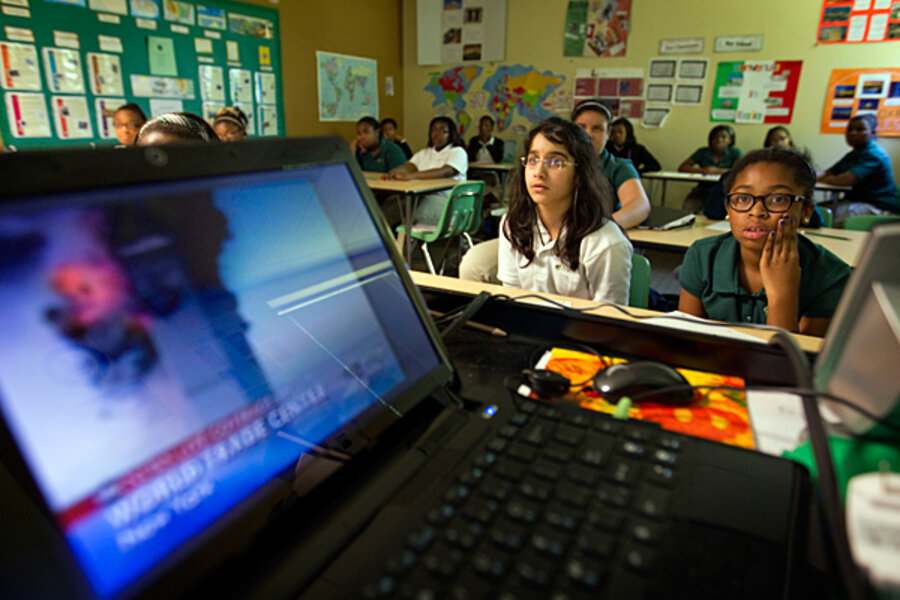Teaching 9/11: How educators are responding 10 years later
Loading...
| Los Angeles
As Diana Hess learned that airplanes had slammed into the twin towers in lower Manhattan on Sept. 11, 2001, her first instinct was to cancel her classes for the day. But before she could, the University of Wisconsin education professor began receiving frantic calls from her students – pleading with her to hold class as planned.
“They were concerned about how to teach about what had just happened,” Ms. Hess says. Her students were student-teachers who taught in classrooms – from kindergarten to 12th grade – in the mornings and attended college courses in the afternoon. “They had little experience with events of this scale and scope, and they wanted to get help on how to teach about the event with their children right away,” she adds.
It was clear early on to Hess that textbooks alone were not going help teachers and students make sense of the events of 9/11. But what was she going to tell her students? How do you teach 9/11?
That question launched Hess on a decade-long study on how this pivotal event in current American history is being taught across the country. Her most recent findings were published Thursday.
Hess found that grappling with 9/11 has forced educators to look to new, more immediate, resources. They have had to remain flexible curators of a heavy stream of audio, video, long- and short-form journalism, and even in-person presentations, to adequately teach a historical event that remains current.
The 9/11 attacks are a commonly required topic in schools – they are specifically mentioned in 21 states' official standards for social studies – but textbooks are often limited in space, so many have little meaningful detail about the actual attack, writes co-author Jeremy Stoddard, associate professor at the William & Mary School of Education.
Efforts to put the events in a larger context, such as domestic or international terrorism, are also hit-and-miss, says Mr. Stoddard. For example, one text defines terrorism as attacks on civilians, yet cites the attack on the USS Cole – a military target – as an example.
Eschewing textbooks as ineffective, many teachers have turned to an ample supply of supplemental materials from a wealth of sources, says Stoddard. “These don’t have to pass state textbook scrutiny and aren’t constrained by the space restrictions of official textbooks.”
Often, these materials tend to reflect the concerns of the organization producing them, he says. For example, a group called Facing History and Ourselves is focused on tolerance and Holocaust work, “so the materials dwell on developing tolerance towards others, in particular Muslims." Another group, Choices for the 21st Century, has developed extensive materials for teaching about 9/11 from a foreign policy perspective.
And Learn360 offers streaming video culled from some 60 sources such as the National Geographic Channel, PBS’s "Reading Rainbow," and the Encyclopedia Britannica.
Teachers have to be creative in dealing with such a fluid and outsize event, says Terrence Sowers, literature and humanities teacher at Summit International Preparatory high school in Arlington, Texas. Mr. Sowers is teaching a month-long unit on 9/11 for the first time this spring. He wanted to focus on artistic expression in his humanities class, he says, and found that he had to cobble together the teaching materials from a variety of sources, mostly from the Internet.
One invaluable resource turned up in his own school – the mother of a student who had been on the street beneath the towers as they fell. She spoke to the class on Wednesday, he says, “and it was so much better than anything they could read or even watch on TV,” he says. “These kids are too young to remember much themselves, so this makes it very real for them.”
Many college students are also too young to recall much from Sept. 11, 2001, says Nico Slate, assistant professor of history at Carnegie Mellon University in Pittsburgh. “They have vague memories of it at best,” he says, pointing out that educators are now moving into an era of students for whom 9/11 must be taught as an historical rather than a current event.
Yet, he notes, the book is hardly closed on what it all means, with new information and events changing the historical narrative all the time.“It can be taught from so many perspectives,” says Mr. Slate. “This is both the challenge and the opportunity.”
[ Video is no longer available. ]





